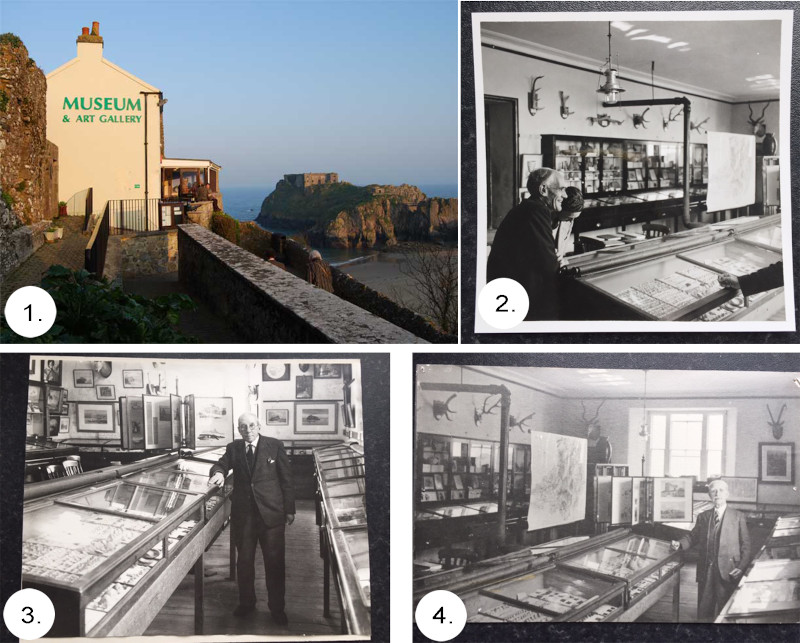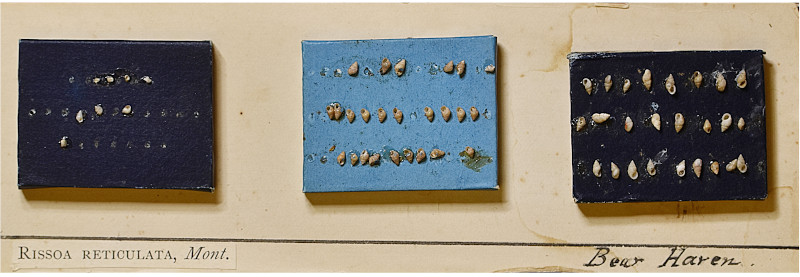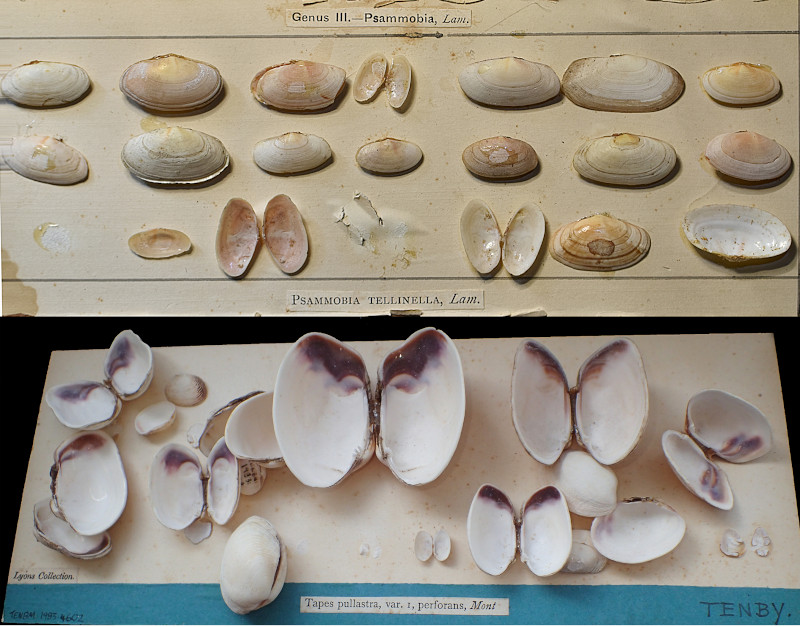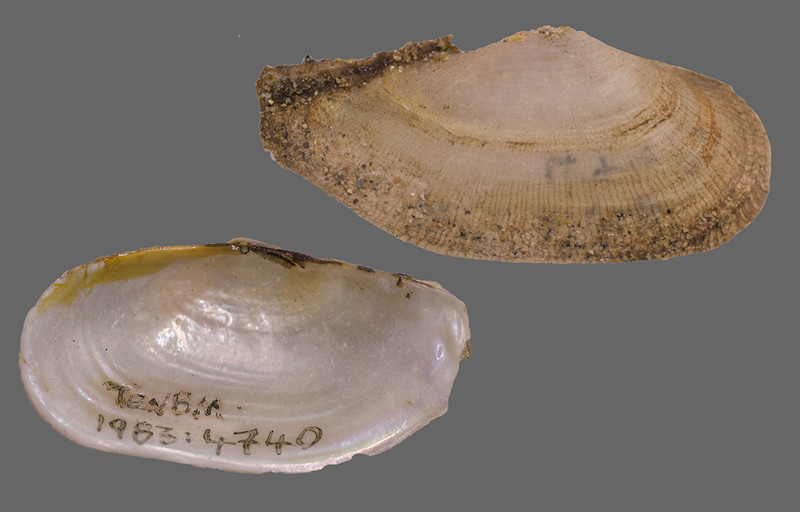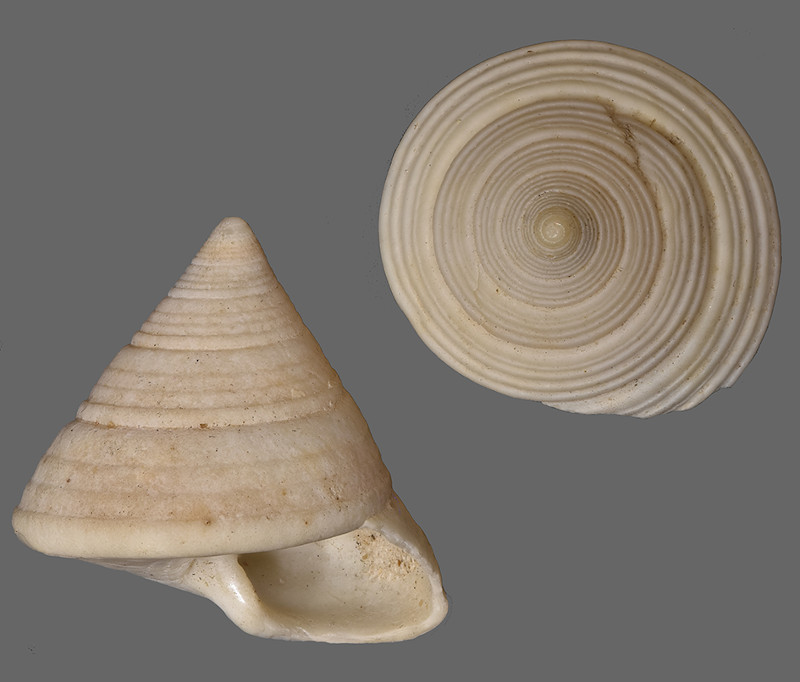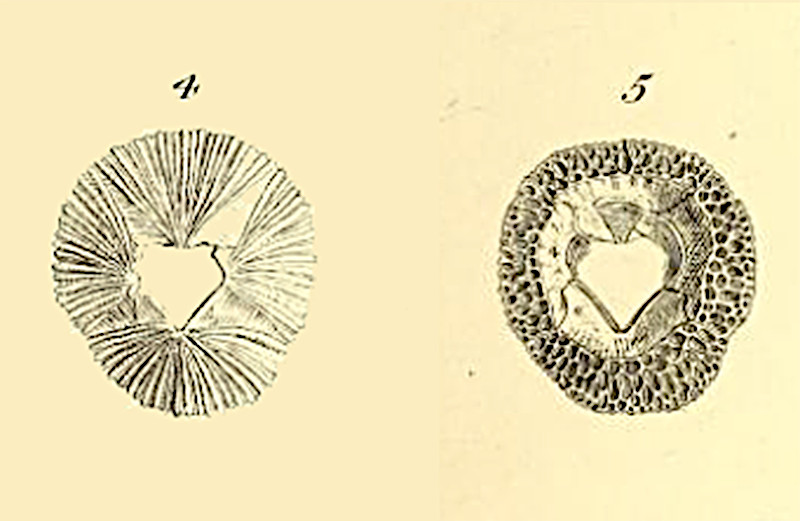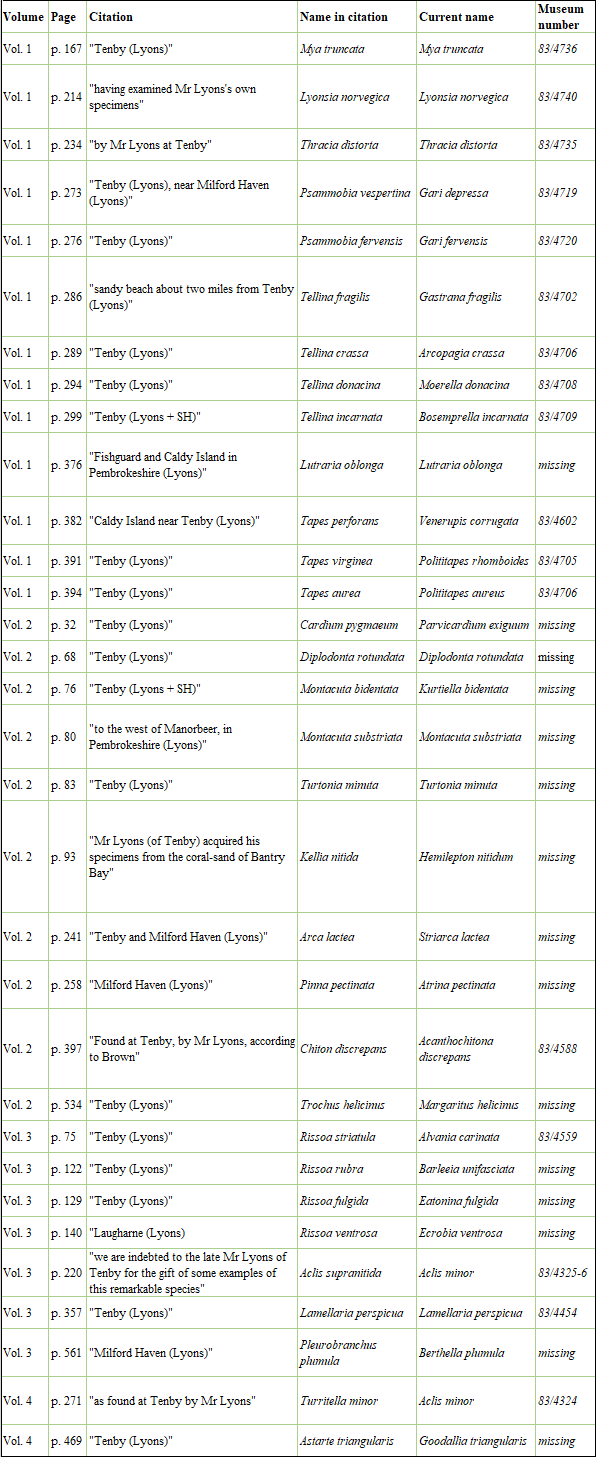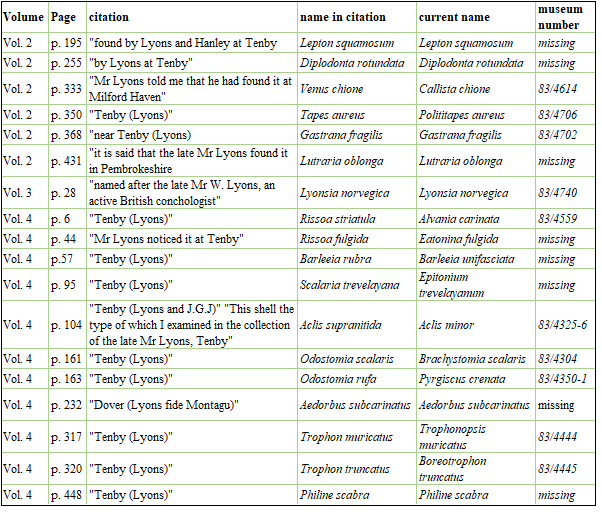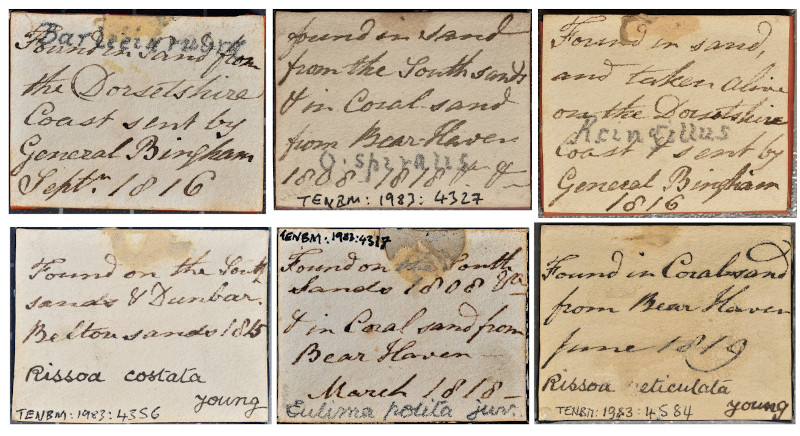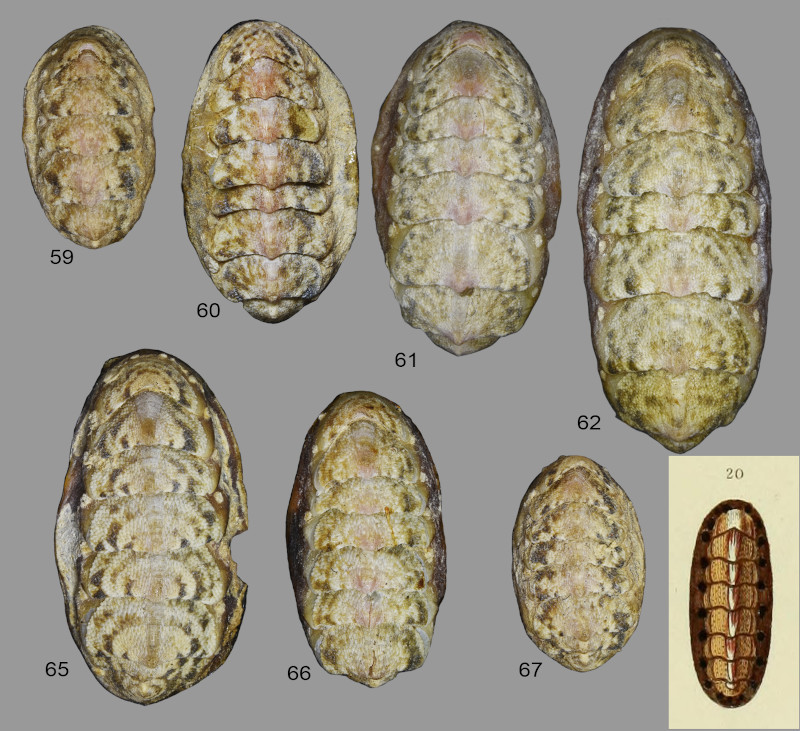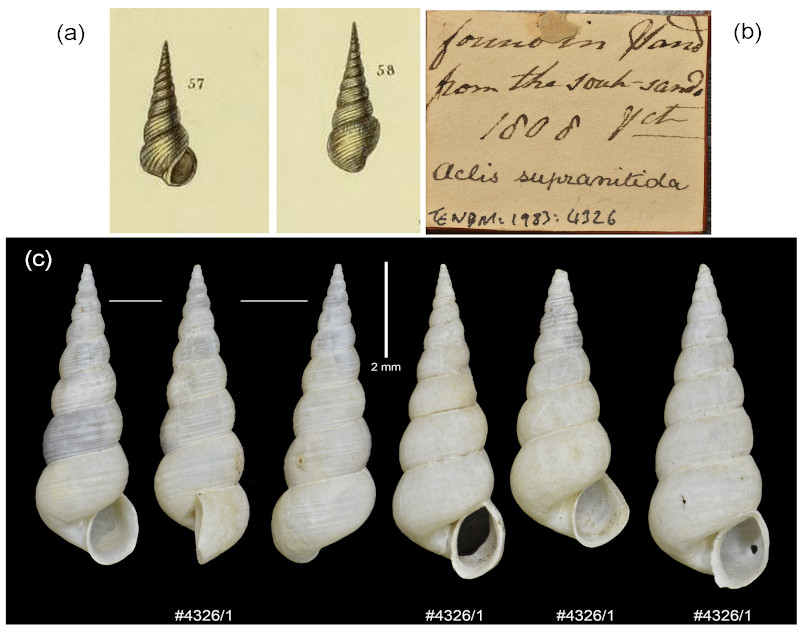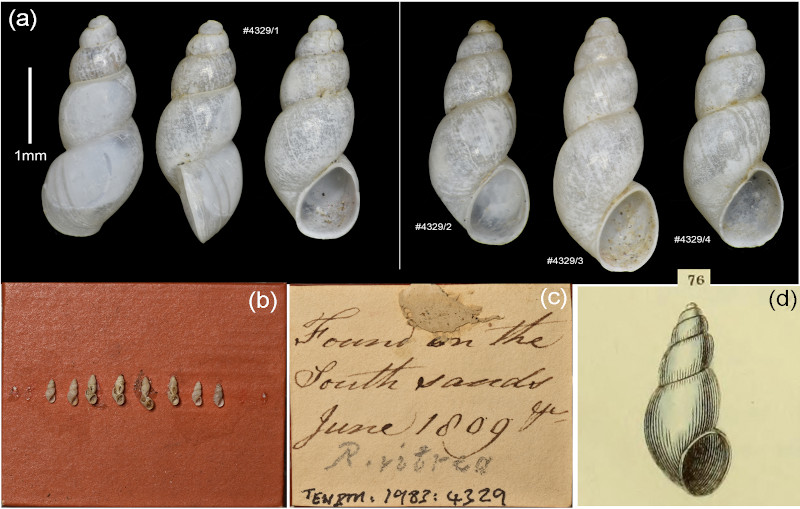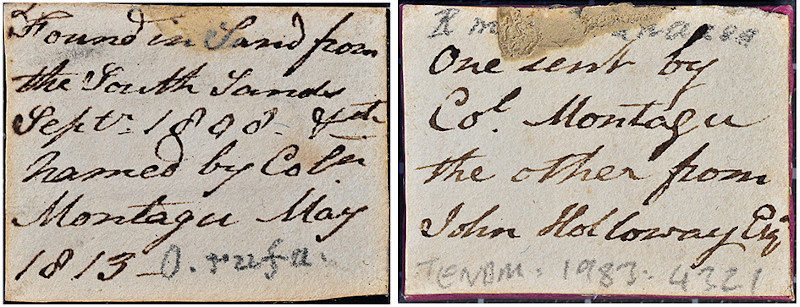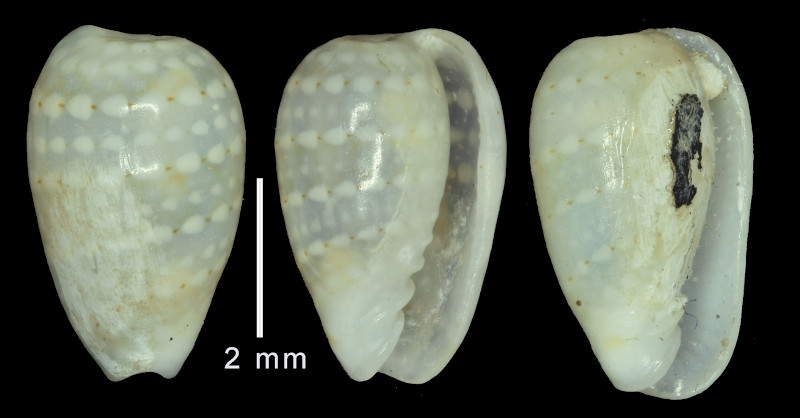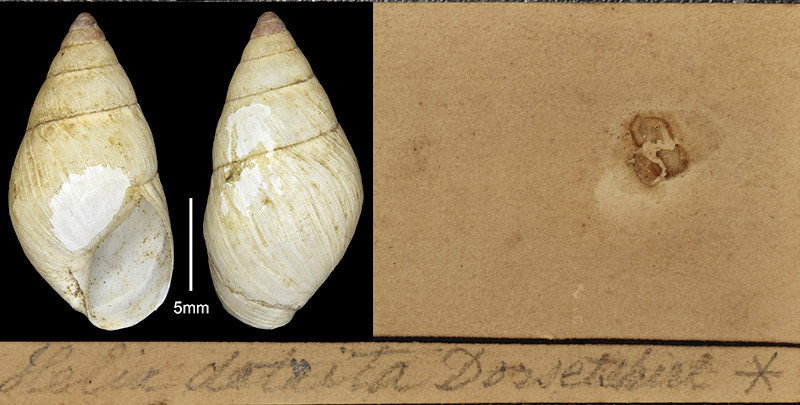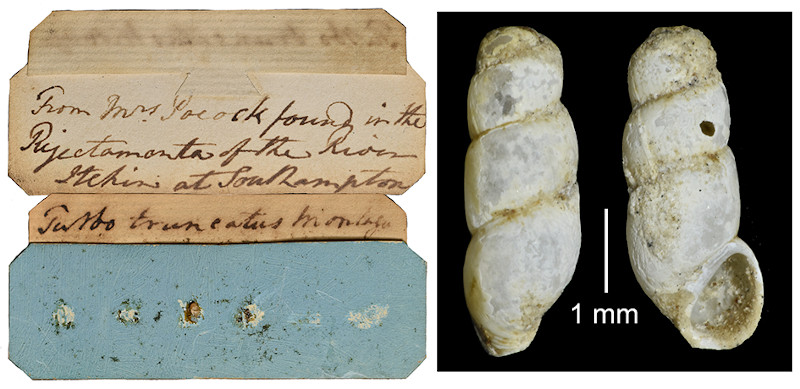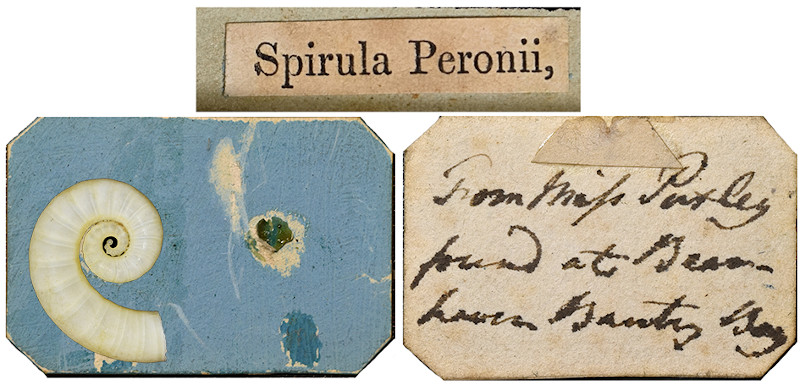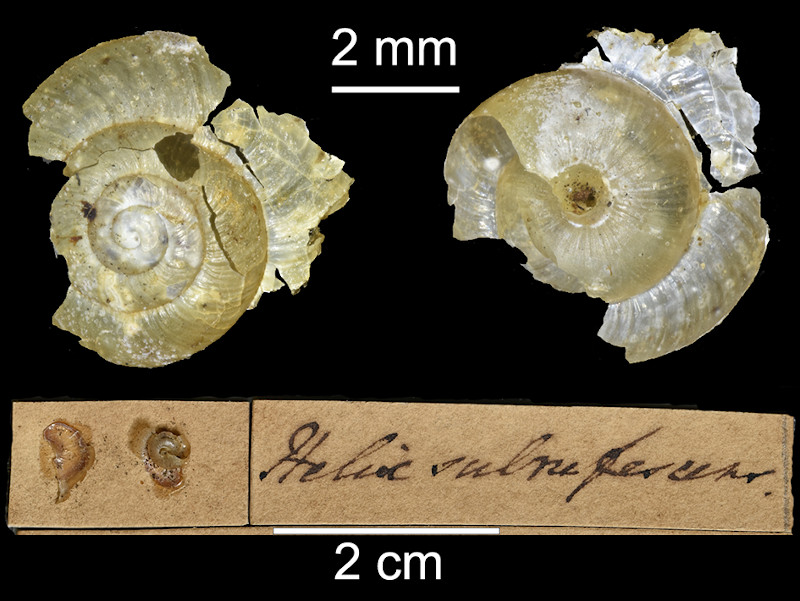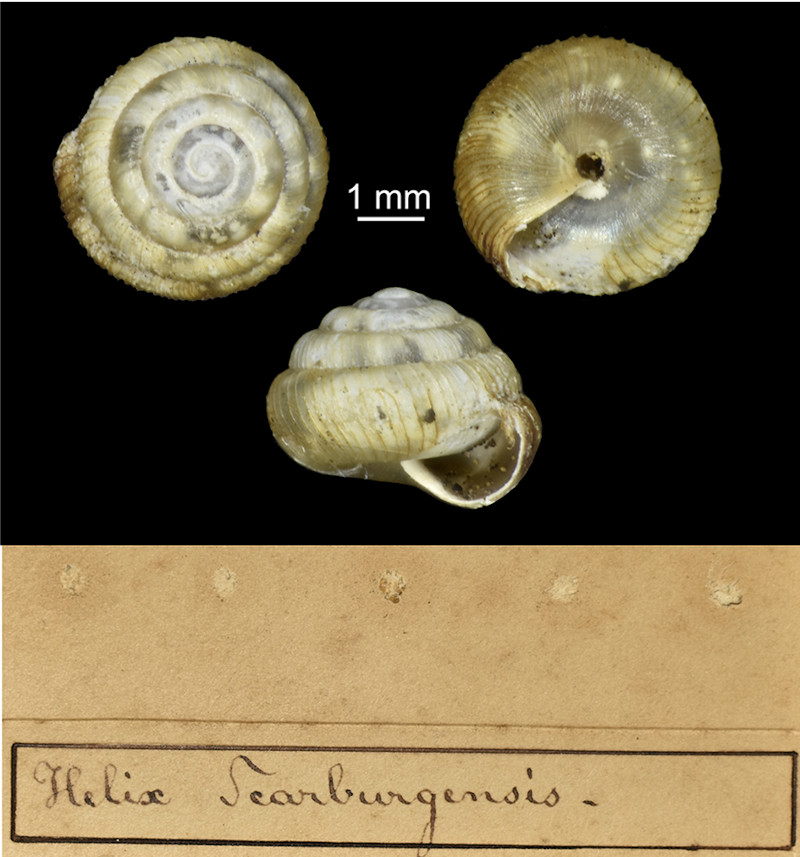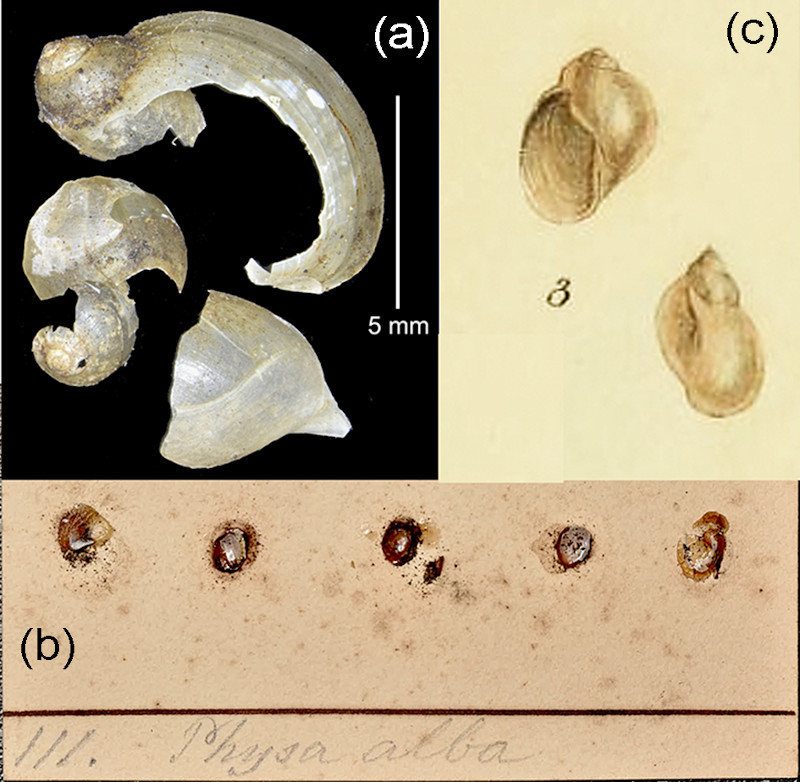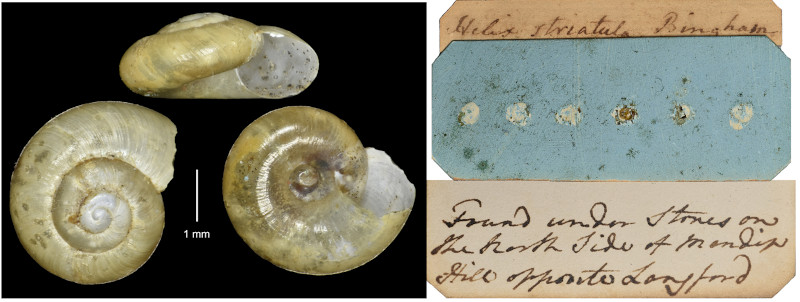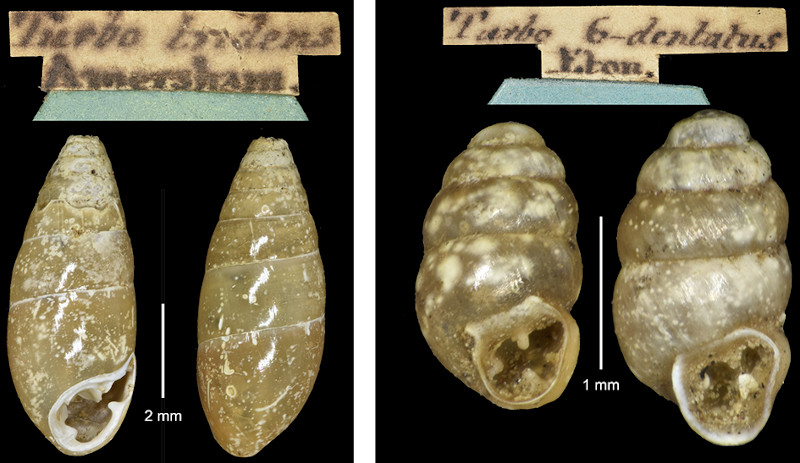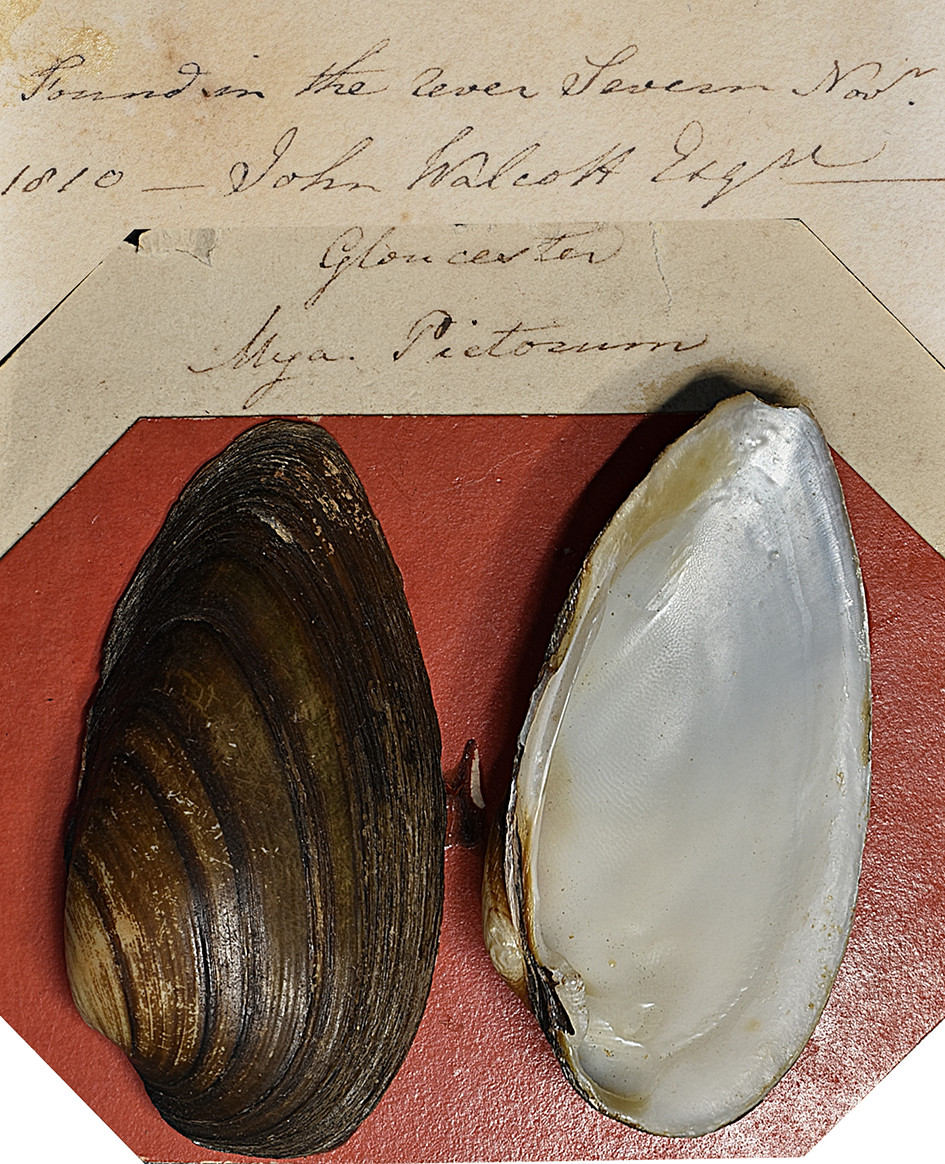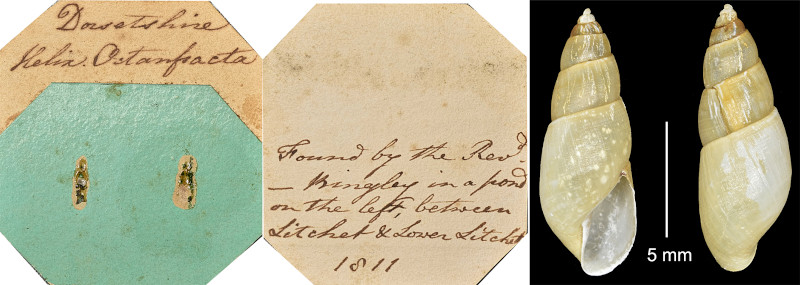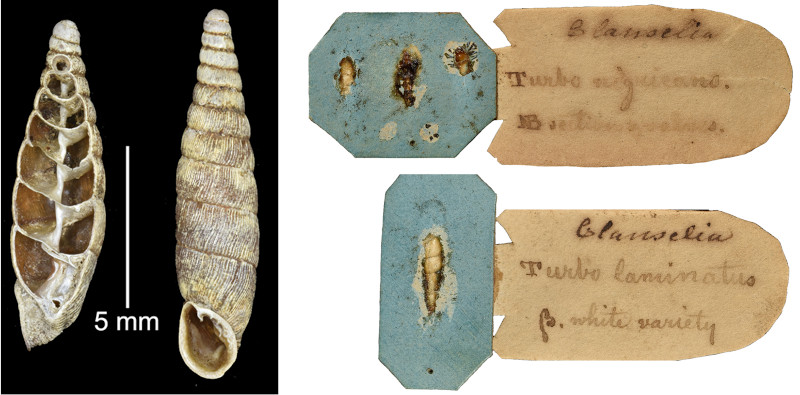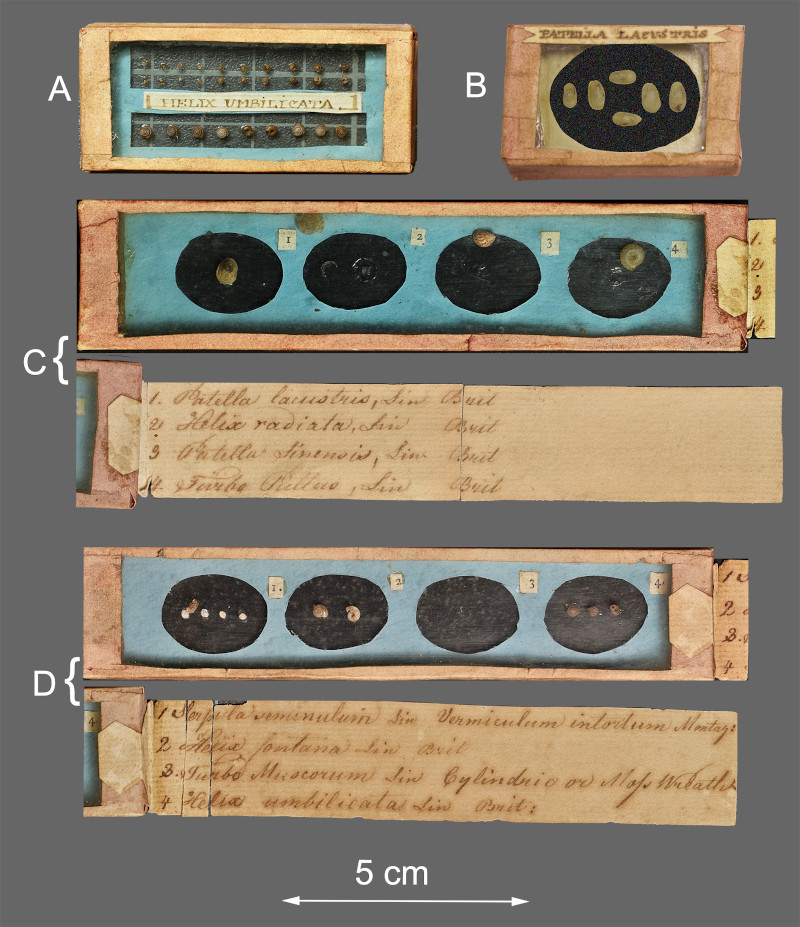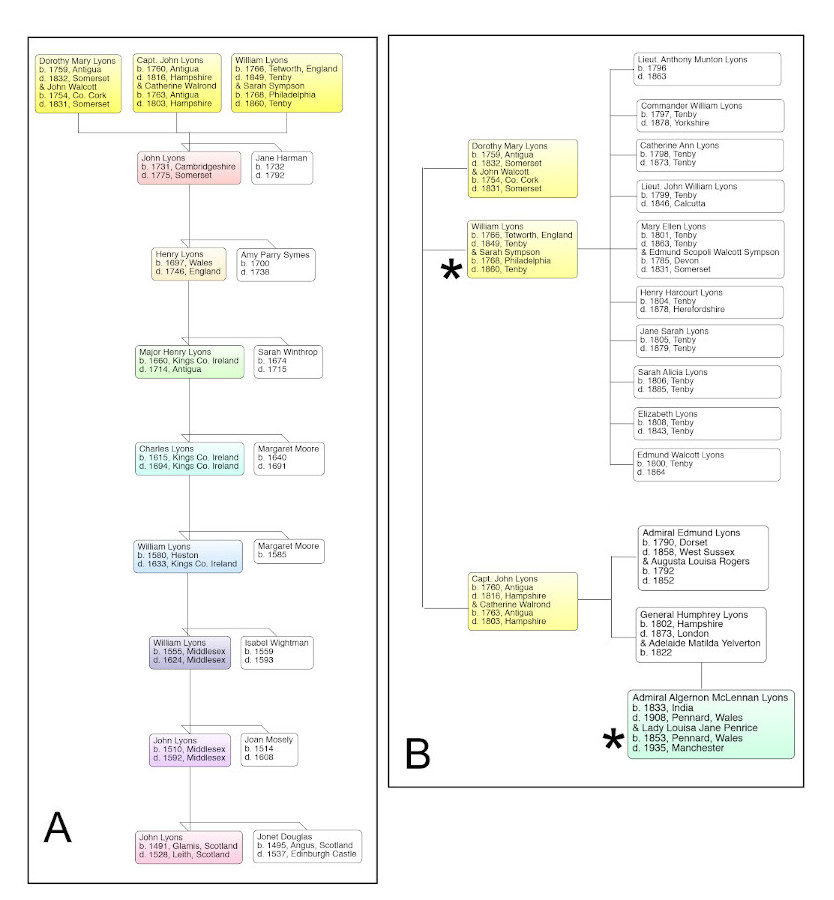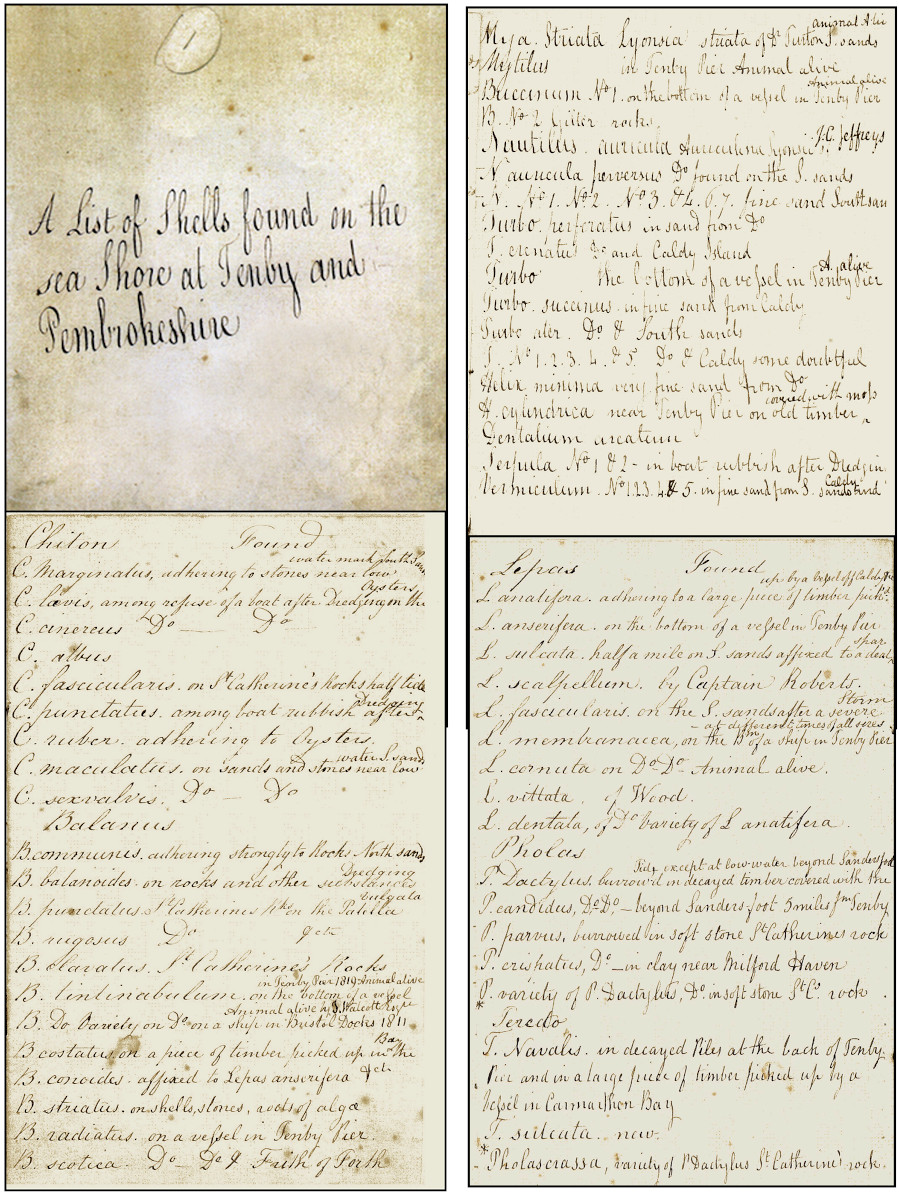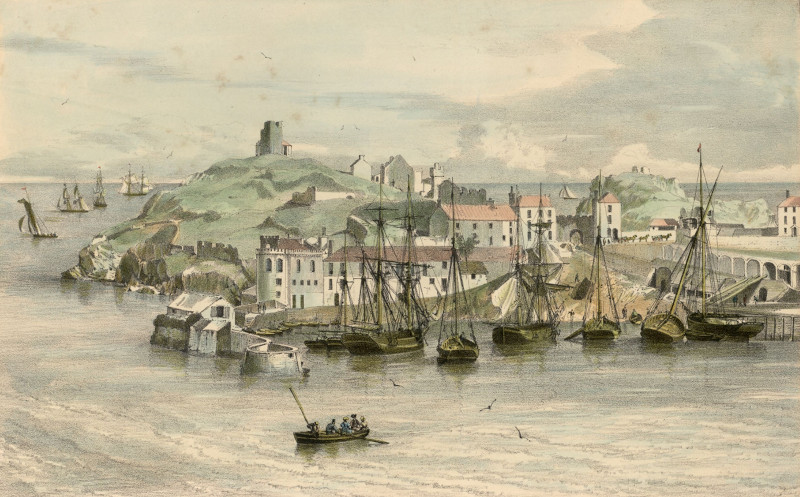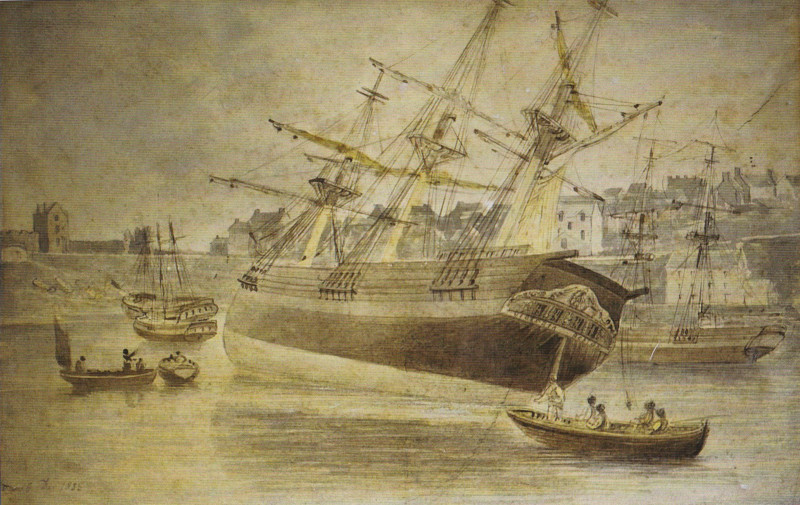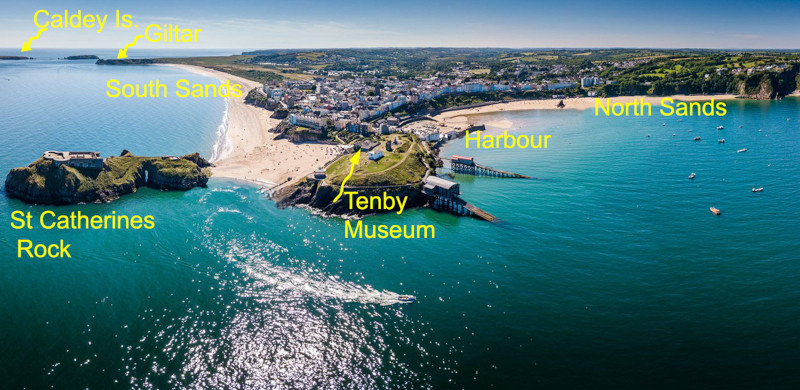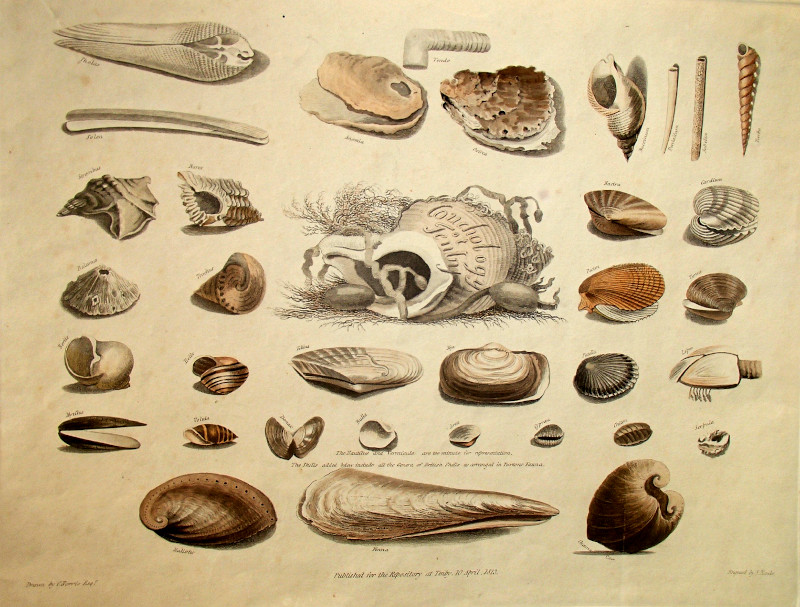William Lyons of Tenby (1776–1849) and his conchology collection in the Tenby Museum & Art Gallery with recognition of type material
William Lyons de Tenby (1776–1849) et sa collection conchyliologique au Tenby Museum & Art Gallery avec reconnaissance du matériel type
- P. Graham Oliver, Kathy Talbot, Barbara Fredriksson, Victoria Tomlinson, Mark Lewis & Douglas Fraser
| Résumé | Plan | Texte | Bibliographie | Notes | Auteurs | Citation |
|
The William Lyons (1776-1849) conchological collection in the Tenby Museum and Art Gallery is one of the few from the early 19th century to survive intact and is the oldest natural history collection in Wales. Lyons was recognised in three eponyms, the molluscan genus Lyonsia and the molluscan species Trochus lyonsii, and the barnacle Conia lyonsii. His collection was extensively cited in the works of Forbes and Hanley, J.G. Jeffreys and Captain T. Brown. Lyons corresponded and received shells from his contemporaries who include Colonel G. Montagu; W. Turton; J.S. Miller; Lieutenant General R. Bingham; Reverend W. Bingley; T. Walcott; Miss Puxley; Miss Pocock and T. Rackett; brief biographies of each are given. Examples of the labels and handwriting of the collectors are illustrated. Type and possible type material is recognized for the following species: Acanthochitona discrepans Brown, 1827; Turritella (now Aclis) minor Brown, 1827; Pyramis crystallina Brown, 1827 (now Hyala vitrea); Helix goodalli Miller, 1822 (now Opeas hannense); Helix (now Zenobiella) subrufescens J.S. Miller, 1822; Physa alba Turton, 1825 (now Physa hypnorum); Helix scarburgensis Alder, 1830 (now Spermodea lamellata) and Voluta catenata Montagu, 1803 (now Gibberula catenata (Montagu, 1803). A manuscript in the hand of William Lyons entitled "A list of shells found on the sea shore at Tenby and Pembrokeshire" is presented and analysed. A brief family history of William Lyons is included. Keywords: historical collection - molluscs - Tenby - type specimens - Capt. T. Brown - J.S. Miller - W. Turton - J. Alder - Col. G. Montagu La collection conchyliologique de William Lyons (1776-1849) au Tenby Museum and Art Gallery est l'une des rares du début du XIXe siècle à avoir survécu intacte et est la plus ancienne collection d'histoire naturelle du pays de Galles. Lyons est reconnu dans trois éponymes, les mollusques Lyonsia, Trochus lyonsii et le balane Conia lyonsii. Sa collection a été largement citée dans les ouvrages de Forbes et Hanley, J.G. Jeffreys et Capt. Brown. Lyons correspondait et recevait des coquilles de ses contemporains dont le colonel G. Montagu, W. Turton, J.S. Miller, le Lieutenant-Général R. Bingham, le Révérend W. Bingley, T. Walcott, Mlle Puxley, Mlle Pocock et T. Rackett ; de brèves biographies de chacun sont fournies. Les différentes étiquettes et écritures des collectionneurs sont illustrées. Les types et le matériel possiblement typique sont reconnus pour les espèces suivantes : Acanthochitona discrepans Brown, 1827 ; Turritella (act. Aclis) minor Brown, 1827; Pyramis crystallina Brown, 1827 (act. Hyala vitrea) ; Helix goodalli Miller, 1822 (act. Opeas hannense) ; Helix (act. Zenobiella) subrufescens Miller, 1822 ; Physa alba Turton, 1825 (act. Physa hypnorum) ; Helix scarburgensis Alder, 1830 (act. Spermodea lamellata) et Voluta catenata Montagu, 1803 (act. Gibberula catenata (Montagu, 1803). Un manuscrit de William Lyons intitulé "Une liste des coquilles trouvées au bord de la mer à Tenby et Pembrokeshire" est présentée et analysée. Une brève histoire familiale de William Lyons est incluse. Mots clés : collection historique - mollusques - Tenby - spécimens types - Cne T. Brown - J.S. Miller - W. Turton - J. Alder - Col. G. Montagu |
The marine molluscs not examined by Kennard (1944)
The non-marine molluscs examined by Kennard (1944)
Lyons's "List of Shells found on the Sea Shore at Tenby and Pembrokeshire"
Lost histories and demise of significant natural history collections in local museums
Appendix 2: Norris's Conchology of Tenby
|
During the first decades of the 19th century William Lyons (1776-1849) amassed a collection of British shells, mainly from around his home town of Tenby in south-west Wales. Although he did not contribute to the scientific literature, his collection was well known to his contemporaries with whom he corresponded and exchanged shells (Dean, 1936; Kennard, 1944). A portion, containing most of the land and freshwater shells, was reviewed by Kennard (1944) in which he recognized a number of secondary collectors such as Bingham, Bingley, Bean, Goodall and Miller and two lots of paratypes. Kennard's statement (1944: 75), “It is of the greatest importance to ascertain what the pioneers meant by the names they used” still holds true today and as was exemplified in the recent review of the Montagu collection (1803-1816) in the Exeter Museum by Oliver, Morgenroth & Salvador (2018). Since the review by Kennard the Lyons collection has received little attention and the marine portion has never been revised. A preliminary review indicated that the collection was no longer accessible physically nor were the associated data available in a useable format. A project was then put in place to research the collection, bring the data up to modern standards and to place the collection in modern storage. This paper summarises the contents of the collection, reports on specimens of taxonomic significance, on the secondary collectors and presents a brief biography of William Lyons. Also included in this paper is an assessment of a manuscript found in the Tenby Museum labelled "Shells of Tenby" not dated but in the handwriting of William Lyons. This item will be referred to as “Lyons mss” throughout this paper.
The collection was made, according to dates on the labels, between 1808 and 1831. William Lyons died in 1849 and the collection remained in the family home, at 5 Market Street, until 1878. In March 1869 in a “Proposal for a public museum” 1 Frederick Dyster (1800?-1893) describes “...the conchological collection of Miss Lyons as forming, if it could be transferred to this museum, a valuable nucleus for a really scientific collection...” In 1878 the Tenby Museum (Fig. 1) was created and was given a lease for a property on Castle Hill, overlooking St Catherine's Island. In a letter, dated 1st April 1878 2, Dr Dyster reported that it was being offered to the museum by Miss Lyons presumed to be Miss Jane Sarah Lyons (1805-1879) the eldest daughter or perhaps Sarah Alicia Lyons (1806-1885); and this was duly accepted. In 1885 conchological books belonging to William Lyons but carrying the signature of C.A. Lyons (Catherine Ann Lyons (1798-1873) were donated to the Tenby Museum by a Miss Janet Lyons 3 (presumed to be a grand-daughter and child of Cdr William Lyons (1797-1878), the eldest son). It is interesting to note that a condition of the bequest was that “the original nomenclature be preserved” something that was sadly not adhered to in the following years. There is no record of the size of the collection at that time and no register of its contents was made and no formal acquisition documentation was kept. Rather quickly it was decided to rearrange the shells and minutes of the Museum indicate that central to this was the Reverend C.M. Phelps. The Minutes indicate that the re-arrangement had begun by 1882 but in 1890 it was reported that Phelps still had museum specimens in his possession and these were returned in 1891 4. Phelps died in 1907 5 and we have no record of him completing the re-arrangement. He made his own collection which was acquired by Y.H. Mills of Haverfordwest and subsequently donated by him to the National Museum of Wales (NMW) in 1916. One lot in that collection contained a typical pale blue Lyons mount suggesting that Phelps had confused his collection with some of Lyons. Another local conchologist, a Mr Bartlet Span, and one-time trustee of the Tenby Museum, was also enlisted 6 to help with the re-arrangement. The Bartlet Span collection of some 5000 specimens was also donated to the NMW in 1915. Then in 1925 staff of the Zoology Department of the National Museum of Wales, including the conchologist J. Davy Dean, were requested to advise on the arrangement and display of the shells 7. Exactly what was done is unclear but correspondence with the NMW continued through to 1976. Alarmingly F.G. North , then Keeper of Geology in the NMW, in 1939 suggested “it would certainly be better to turn out some of the shells (displayed in Tenby museum) in order to accommodate fossils” 8; what actually was done is not known. Throughout this period only J. Davy Dean and A.S. Kennard emphasised the historical importance of the Lyons collection. Despite all the correspondence about re-arrangement, no-one suggested cataloguing the collection or applying basic curatorial management practices to it. In 1980 the collection was removed from display and a team of volunteers was tasked with data basing the specimens, using the collection management system Modes. The lack of conchological experience during this process did nothing to highlight the historic nature of the collection, and nor was the physical conservation improved. Figures 2–4 show the natural history gallery as it was in 1939 and the Lyons shells can be seen arranged on wooden slats in the cases.
Today the collection consists of 340 lots of dry molluscan shells representing 216 species. The number of lots of the main categories are given in Table 1 along with the number of species represented. The Lyons list (Lyons mss) of Tenby shells gives 245 species but the disassociation of data has been such that only about one third of the lots now carries locality data. For the majority of specimens it can only be assumed that they came from Tenby. Seventy-four lots did not come from Tenby and among these 21 came from Bear Haven, Bantry Bay in Ireland, 21 from the south coast of England, 12 from Scarborough and 15 from Somerset.
The marine shells in particular have been extensively used for exhibition and many have no direct attribution to Lyons in that they carry no original labels or mounts. Their provenance is only indicated by the addition of “Lyons coll.”, either in hand writing or as typed labels, by subsequent curators. The land and freshwater Mollusca examined by Kennard (1944) appear never to have been put on display or re-arranged by Phelps. They retain the bulk of their original mounts and labels and include shells gifted to Lyons from other collectors and locations other than Tenby. It is likely that the origins of these shells outside of Tenby excluded them from the attention of Phelps and others who were focussed on displaying only shells from Tenby. The marine shells have been subjected to greater disturbance and a smaller proportion remain with their original mounts. The original Lyons mounts among the marine shells consist of small rectangular blocks covered on their upper surfaces by coloured paper of various shades (Fig. 5). At one time these blocks were attached to wooden slats for display and these slats contained the identifications (Fig. 5). The reverse is plain and carries the locality data in Lyons' hand but no identifications (Fig. 6), these have been added at a later date by subsequent researchers or curators. Remnants of adhesive remain on the reverse sides and often obscure the data. Larger shells were completely removed from their original mounts and fixed directly onto wooden slats (Fig. 7). Their provenance may be a printed label or hand-written stating “Lyons Collection” on the front of the slat or this information may be written on the reverse.
Much of the material examined by Kennard (1944) was gifted to Lyons by his contemporaries and some retain the label styles of these collectors or have been remounted by Lyons himself. These appear not to have been on display and these will be considered separately under each secondary collector Lyonsia W. Turton, 1822 (Bivalvia, Pandoroidea) (Fig. 8). Type species Mya striata Montagu, 1816. The type species was described by Montagu (1816: 188) who also acknowledged Lyons by writing. “This new and interesting species, it appears, was discovered by Mr Lyons in Tenby-bay on the south coast of Wales, from whence specimens were sent to Mr Norris who obligingly favoured me with that form from which the above description is taken; and I have been reassured by the Rev Mr Bingley that several more have been taken recently by the same gentleman after a storm, which were all alive.” For Norris see Appendix 3 and the Rev Mr Bingley is dealt with below.
Lyonsiella G.O. Sars, 1872 Trochus lyonsii Fleming, 1828 (Fig. 9)
Conia lyonsii G. B.Sowerby I, 1823 (Fig. 10) The previous two eponyms were originally given by W.E. Leach (Harrison & Smith, 2008) who during the period of 1815-1822 was the Keeper of Zoology in the Natural History Museum, London. Leach left his position following a nervous breakdown in 1822 and we have no direct archival evidence of correspondence between the two men. Neither publication mention William Lyons directly but Leach mss (in library of NMW) does cite material first collected by Lyons.
The marine molluscs not examined by Kennard (1944) An indication of the value of the Lyons collection to his contemporaries can be gleaned from the citations in some standard works of the era, primarily Forbes & Hanley (1848-1853) (Table 2) and Jeffreys (1862-1869) (Table 3). Lyons is cited 32 times in Forbes and Hanley and 18 times in Jeffreys. Both authors describe visiting the Lyons collection; (Forbes & Hanley, vol. 1: 214) and (John Gwyn Jeffreys, vol. 4: 104). Lyons is also cited in Turton, 1822 and in Brown, 1827. |
|
|
The collection was visited by two persons who gave identifications by writing these on the reverse of the wooden blocks (Fig. 11). These identifications are often partly obscured by glue and were thus made before the collection was attached to the wooden slats as seen in the display cases and in Figure 5. The identifications written in a primitive style in pencil (top row) are by a person unknown to us but the handwriting on the bottom row is that of J.T. Marshall (1842-1922). Marshall (1893-1912) compiled a series of papers entitled “Additions to British Conchology” and one suspects that he was using the Lyons collection to verify records. We have no direct evidence from Tenby Museum archives of his visit.
Thomas Brown (1785-1862) was a Scottish naturalist and conchologist. He is best remembered for his Illustrations of British Conchology (1827 and reprinted and expanded in 1844) in which he introduced many new genera and species, very few of which gained acceptance. He became curator of the Manchester Museum in 1840 but very little of his shell collection has been recognised (Jackson, 1944; McGhie, 2008). Brown is not mentioned in the labels of the Lyons collection but Brown does refer to shells in Lyons collection and having examined some, from which he described new species. For one species a lectotype has been chosen (Kaas, 1985) but for others, type material has not been located although the species are represented in the collection. In Brown (1827, 1844) he refers to Lyons as George Lyons of Tenby, but this must be an error as there was no George Lyons living in Tenby at that time and none with a collection of shells from Tenby.
Chiton discrepans Brown, 1827 now Acanthochitona discrepans (Brown, 1827) (Fig. 12)
Turritella minor Brown, 1827 now Aclis minor (Brown, 1827) (Fig. 13) Type material: Syntypes: 4 shells as Aclis supranitida S.V. Wood, 1842 Found in sand from the South Sands, 1808. TENB 1983.4325, det. J.T. Marshall. No formal description was given in 1827, only illustrations. A brief description was given in 1844 but was not regarded as sufficient by Forbes and Hanley (1853: 271) to distinguish it. They correctly point out the error in Brown's dimensions. Aclis minor is included in Forbes and Hanley (1850) but under Aclis supranitida SV Wood where they acknowledge a gift of this species from Lyons. If these shells exist they may be regarded as part of the syntype series.
Pyramis crystallinus Brown, 1827 now Hyala vitrea (Montagu, 1803) (Fig. 14) Type material: Possible syntypes, 8 shells attached to a brick-red wooden block. “Found on the South Sands, June 1809” in Lyons hand. TENBM 1983.4329/1-5. As Rissoa vitrea det. Anon. 4 separated off as 1983.4329/1–4, 4 damaged shells attached to wood block as 1983.4329/5.
Myatella montagui Brown, 1844 Brown (1844) introduced the generic names Magdala and Myatella and the new species Myatella montagui but all are compounded around Montagu's Mya striata and Lyonsia of Turton. Myatella montagui is credited to shells discovered in Tenby by Lyons but it is clear that these are the same shells described by Montagu as Mya striata. All the names here have been placed into the synonymy of Lyonsia norvegica in MolluscaBase (2020).
We already know that Lyons was acquainted with Col. George Montagu through the description of Mya (Lyonsia) striata. From annotations on the Lyons blocks (Fig. 15) we also know that Lyons received shells from Montagu and that Montagu identified shells for Lyons. The Lyons collection contains other shells that may have come from Montagu and may have some taxonomic significance. It is however unfortunate that the disassociation of data from the shells within the Lyons collection has left this a matter of conjecture.
Voluta catenata Montagu, 1803 now Gibberula catenata (Montagu, 1803) (Fig. 16) Type material: Possible syntypes: 3 shells as Gibberula miliaris. TENB 1983.4515, det. Anon.
Helix detrita Montagu, 1803 now Drymaeus elongatus (Röding, 1798) TENBM 2001.192.02 (Fig. 17). This is another neotropical shell described by Montagu as British (Oliver et al., 2017) and was given to Montagu by Mr Bryer who found it at Weymouth and Dorchester. The two shells in the Lyons collection match exactly and are labelled as coming from Dorsetshire, it seems plausible that Lyons's shells are part of the same lot seen by Montagu but from whom Lyons got them is not known. Dorsetshire localities in Montagu (1803; 1808) are frequently linked to a Mr Bryer and to a lesser extent a Miss Pocock who is more fully acknowledged by Donovan (1802: pl. 125).
Donovan (1802) says of Miss Pocock when describing Mactra glauca “the conchologist is indebted to Miss Pocock for the discovery of it on our shore. The attention with which this lady has honoured the science has not been rewarded by this new species only: we have been favoured with several others, besides many rare kinds that have been found by her on different parts of the sea-coast.” A Miss Elizabeth Pocock is mentioned in J. Sowerby (1812: 14; 1818: 22) as donating shells from Marazion in Cornwall and therefore probably the same person. Turk (1979) suggested that this Miss Pocock may have been part of the family of Nicholas Pocock (artist, b. 1741) and brother of Nicholas Pocock (marine captain out of Cornwall from 1804-1811), but this is supposition. Unfortunately, we have been unable to find any confirmatory biographical data for this lady but record here that she also sent shells to Lyons (Fig. 18), lots #2017.08, #1983.4741 and #2001.129.04.
There are 21 lots present bearing the locality “Bear Haven” a location in Bantry Bay, SW Ireland. There is a single label linking their provenance to a Miss Puxley (Fig. 19). However, Lieut.-General Bingham is also implicated as Leach in Gray (1852) notes that a J.L. Puxley sent a shell to Gen. Bingham that Leach subsequently described as Buccinum puxleianum (now Buccinum humphreysianum Bennett, 1824). Brown (1827, 1844) describes his Brochus arcuatus as “Found in sand, at Bear Haven ---- by General Bingham, in his cabinet”.
As Lyons received shells from Bingham, both Bingham and Puxley are possible sources. A Mrs Puxley is cited five times by Forbes & Hanley (1853) and four times by Jeffreys (1862-68). The JL Puxley mentioned by Leach in Gray (1852) can be traced to a John Lavellin Puxley formerly of Cork and listed as a landowner in the parish of Bear Haven. He and his family subsequently appear in the 1841 census of Laugharne (Pembrokeshire) and again in 1851 now in Tenby. In this last census they have a visitor, one Jane Lyons (1805-1879) eldest daughter of William Lyons. This is the daughter who donated some of the conchological books belonging to William Lyons to Tenby Museum in 1885. Bantry Bay is a frequent locality in shell collections probably because of the diverse species to be found in the coral (maerl) sands. The locality appears in the biological literature first in 1809 (Lyne, 1983) when Lewis Weston Dillwyn, William Elford Leach and Joseph Woods make a collecting trip and visit the famous Irish Botanist Ellen Hutchins at her home in Ballylickey, Bantry Bay. (Harrison & Smith, 2008). Although most well known as a botanist Ellen Hutchins also collected shells and Leach named Persiphona hutchinsiana [now Alvania cimex (L. 1758)] for her after a shell she sent to him (Harrison and Smith, 2008; 99). William Turton and his daughter acknowledge the hospitality of the 1st Earl and Countess of Bantry (Viscount Beerhaven) at their “noble house” Bantry House and note some shells collected there (Turton,1819: 260).
The non-marine molluscs examined by Kennard (1944) J.S. Miller (?-1830) was Curator of the museum in Bristol during the early part of the 19th century. He was primarily interested in palaeontology, particularly crinoids. He wrote a single paper (Miller, 1822) on the land and freshwater molluscs of the Bristol district. In this paper he describes Turbo everetti, Helix allaria, Helix subrufescens and Helix goodalli. The presence of trade cards in the Lyons collection suggests that Miller was a serious collector and probably had a formal arrangement for exchanging shells. A biography of Miller can be found in the Philosophical Magazine (Anonymous, 1831). Kennard (1944) attributed 8 lots to JS Miller the most important taxonomically being two lots attributable to new species described by Miller. Their significance was noted by Kennard (1944) who suggested they may represent paratypes but the loss of the Miller collection in Bristol due to bombing of the museum during the Second World War raises their status to syntype.
Helix goodalli J.S. Miller, 1822, now Opeas hannense (Rang, 1831). Type locality: The pineries at Bristol (Fig. 20a).
Helix subrufescens J.S. Miller, 1822, now Zenobiella subrufescens (J.S. Miller, 1822) (Fig. 21).
J.S. Miller Trade Cards
William Bean II (1787-1866) of Scarborough is well known for the extensive collections that he amassed and his generous nature through the exchange of specimens (McMillan & Greenwood, 1972). Kennard (1944) recognised 10 lots in the Lyons collection all attached to the distinctive mounts of Bean's collection. Of these one may have some taxonomic significance. Helix scarburgensis Alder, 1830 now Spermodea lamellata (Jeffreys, 1830) (Fig. 23) Type material: Possible syntypes. 3 shells and 1 fragment. No Locality. Leg. W. Bean. TENBM. 2001.129.37.
William Turton (1762- 1835) was as a physician and worked in Swansea for 15 years, moving to Dublin, Teignmouth, Torquay and finally settling in Bideford in 1831. He was a contemporary of Col. G. Montagu, Forbes and Jeffreys and wrote a number of seminal works, notably his Conchylia Insularum Britannicarum (published in 1822). Turton's collection came into the possession of Jeffreys and is now incorporated with the latter in the USNM. The genus Turtonia was dedicated to Dr Turton by Alder, 1848. Physa alba Turton, 1826 now Physa fontinalis Linnaeus, 1758. Type material: Possible syntypes as Fragments. Formerly attached to a beige card marked in pencil with “111. Physa alba”. TENBM 2001.129.05. (Fig. 24).
We know from the literature that William Turton corresponded with Lyons but there seems to have been very little exchanging of specimens. Kennard (1944) considered one lot to have come from Turton because of the reference to “111” on Lyons' card which is a direct reference to Turton's Manual of 1831. If so Kennard considered these to be paratypes of Physa alba Turton and considered that they match the original figures. On the Smithsonian catalogue we could find no reference to this species in its original name or current name of Physa fontinalis with the type locality of Towyn, Wales. If Kennard is correct then these shells could act as syntypes but they are now in fragments and scarcely recognisable.
Lieut.General Richard Bingham (1741- 1824?). Officer in the Dorset Militia. Resided Melcombe Horsey in the parish of Melcombe Bingham near Dorchester, Dorsetshire, England. He carries the eponyms of Sphenia binghami Turton, 1819, Pyramis binghami Brown, 1827, Binghami paradoxus Brown, 1827 and Sabanea binghamiana Leach, 1852. He was described variously as “our diligent fellow-labourer among the rocks of Torbay” (Turton, 1819); “an assiduous collector of British shells” (Jeffreys, 1864); “indebted to the exertions of his friend General Richard Bingham” (Brown, 1827). In contrast “General Bingham was notorious for being imposed on as to indigenousness” (Jeffreys’ letter in Forbes & Hanley, 1853). This would imply that his locality data were not to be trusted and this might stem from the thirty-nine new species described by Brown (1827) from shells collected by Bingham, primarily from Dunbar and Belton Sands in East Lothian, Scotland. These localities are exactly those so often given by the mistrusted Captain Laskey (1811) in his “Account of North British Testacea” (Oliver et al., 2017; Oliver & Morgenroth, 2018). Regardless of Bingham's reputation he did gift shells to Lyons, some of the marine shells directly indicating their provenance but others probably indirectly (Fig. 25). Those lots carrying localities of Dunbar and or Belton Sands (Fig. 25) probably all came from Bingham.
Kennard (1944) also attributes a series of 15 terrestrial molluscs collected in north Somerset to General Bingham. These consist of a pale blue card to which the shells were attached; the identifications are on a paper attachment and the locality is on the reverse of the card. One lot (Fig. 26) carries the label “Helix striatula Bingham”, a manuscript name suggesting that these lots came from Bingham. Kennard (1944) was not totally convinced of this provenance and we could not find any connection between the Bingham family and a property in the vicinity of Langford or Churchill Batch.
Dr Rev Joseph Goodall (1760-1840) was Provost of Eton and an ardent shell collector purchasing at auctions such as that of the Tankerville collection; his shells are mostly now in the Natural History Museum London (Dance, 1986). A number of eponyms were given including Helix (now Azeca) goodalli Férussac, 1821. Kennard (1944) recognised 3 lots that he attributed to Goodall (Fig. 27). Of these one is of interest as it consists of a topotype of Azeca goodalli. The single shell was attached to a pale blue-green hexagonal card with an attached paper label reading “Turbo tridens, Amersham”. The syntypes of this species are in the Muséum National d’histoire Naturelle, Paris.
John Walcott (1754-1831) was a naturalist who wrote on diverse subjects and was an early disciple of Linnaeus. He lived in various houses in and around Bath although he rather eccentrically rented country properties moving around frequently (Torrens, 2004). The Walcotts and Lyonses had their family roots in south-west Ireland and were to be connected by marriage when in 1783 John married William Lyons' sister, Dorothy Mary (1759-1832). Marriage between the two families continued when Mary Ellen the (sixth child of William Lyons) married Edmund Scopoli Walcott (third son of John Walcott) in Tenby in 1817. A further example of Walcott's eccentricity was the naming of his sons after famous naturalists Edmund Scopoli (b. 1785), John Lyons Ray (b. 1788) and William Henry Linnaeus (b. 1790). Only a single lot in the shell collection reflects the above link however Walcott was not a shell collector but was known for his fossils (Torrens, 1976). The shell is that of Unio tumidus Retzius, 1788 taken from the River Severn, in 1810 (Fig. 28).
William Bingley (1774-1821) was an English cleric, naturalist and writer (Courtney, 1886). He was a fellow of the Linnean Society and wrote on both botanical and zoological subjects. He is not recognised as a shell collector. A single lot is attributable to Bingley as indicated on Lyons's label (Fig. 29). The two shells were identified as Helix octanfracta Montagu, 1803 and at that time was considered rare. The exact locality of 'a pond between Litchet and Lower Litchet' is to be found in Maton & Rackett (1807, p.212) who wrote “This is either a rare or very local species” -- We have procured it from a gravel pit between Litchet and Lower Litchet, Dorset. Helix octanfracta is now a synonym of the Omphiscola glabra (O.F. Müller, 1774) a widespread but very local species that is not well represented in large museum collections (pers. comm. Ben Rowson).
Thomas Rackett (1755-1840) was an English cleric, antiquary and naturalist (Watkins and Davies, 2004). Working with William George Maton (1774-1835) he wrote a history of early conchologists (Maton & Rackett, 1804) and a catalogue of British shells (Maton & Rackett, 1807). Kennard (1944) tentatively attributes 6 lots to Rackett but he gave no reasons for this assumption, he may have recognised the label style (Fig. 30) although there is no known depository for the Rackett collection.
Among the Lyons collection are four glass mounts that were not reported upon by Kennard (1944). The shells are sandwiched between two glass plates and visible on both sides through a window cut in the inserted card mount. The script on the labels is not that of Lyons but despite being intricate and very distinctive we have been unable to verify their provenance. Both writing styles are however similar to those seen of the trade cards of J.S. Miller (see Fig. 31). In Turbo for example the right tail of the T is extended and reflected over most of the word. The block printing in capitals are alike.
Prepared by Douglas Fraser for Tenby Historical Society reprinted from http://www.tenbyhistoricalsociety.org.uk/downloads/William_Lyons.pdf. |
|
William Lyons of Tenby (1766-1849) Origins William Lyons was the descendent of an Irish family although the very early origins suggest they can be traced back to the Lords of Glamis of Glamis Castle in Scotland. At some point in the seventeenth century the family acquired estates in Ireland with the family seat at Lyons River, Kings County. His great grandfather, Major Henry Lyons served in the West Indies where he married Sarah Winthrop whose father was to become Governor of Antigua. In addition to the Antiguan estates that he thus inherited, Major Lyons made considerable land purchases, building up a substantial property, which he left in the charge of his fourth son, Samuel when he returned to Ireland. Henry's son, William's father, John of Sturtlow House, Huntingdon and Antigua married Jane, the daughter of Colonel Samuel Harman of Harman's Antigua, in 1753. His estates were left primarily to his eldest son, John who was a member of the Council of Antigua in 1782. Thus, the Lyons family acquired substantial sugar producing estates in Antigua, but it was also a large family and it is quite difficult to establish just how prosperous any individual member was. William himself was one of ten. His eldest brother, John, had eighteen children by two marriages; some joined the armed forces and some travelled extensively, one became very prominent (Edmund was an admiral and subsequently first Baron Lyons of Christchurch). We know from his will that William's marriage settlement provided him with £2000 from the Antiguan estates but his circumstances otherwise suggest that he was of independent means but not particularly wealthy. William's estate was left in its entirety for the benefit of his wife and unmarried daughters, his sons appear to have had to make their own way in life. The family also led a very retiring life; there is virtually nothing about them in the newspaper archives, just the occasional announcement of a marriage or a birth. Life in Tenby William's family lived in a town house in Market Street (now Tudor Square) Tenby where he and his wife Sarah (née Sympson) lived until her death in 1860. There is no record of them having owned the land, so we may assume that they rented. William himself was born in Tetworth, Huntingdonshire in 1766 and lived in Tenby from at least 1796 when their first child, Anthony, was born until the birth of his youngest in 1811. William and Sarah and their unmarried daughters: Jane, Sarah and Elizabeth, are recorded in the 1841 census for Tenby and William is known to have died there in 1849. The family is mentioned in the “gentry” section of Piggotts 1830 directory of Tenby but in 1844 the only reference is to a Miss Lyons - which may mean that William and Sarah were living somewhere else at the time (in 1837 they were in Bath but still describing themselves as being of Tenby). Sarah with Catherine and young Sarah are shown at no 5 Market Street in the 1851 census. It is difficult to establish how well travelled William Lyons was, especially in the first 30 years of his life (given the occupations of his predecessors and descendants, it might be expected that he joined the armed forces but no record has been found). In addition to the Antiguan connection, his family could be found in all parts of the world including India and the United States as well as the West Indies. His wife, Sarah (Sympson) had been born in Philadelphia in 1768. However, as noted above, virtually every historic reference to William's whereabouts is to Tenby. But why did he settle in Tenby in the first place? One intriguing possibility is because it was the home of Catherine and William Routh. William Routh was a Bristol printer who, in 1790, commissioned the Regency architect John Nash to design a house in Tenby. His wife, Catherine Davies, was the grand-daughter of Thomas Howell who had made his fortune in Antigua before buying Prinknash Park in Gloucestershire in 1776. Was there a connection, by blood, marriage or merely friendship between the Howell and the Lyons families? Children William and Sarah had thirteen children: Anthony, William, Catherine, John, Edmund, Mary, Charles, Henry, Jane, Sarah, Elizabeth, Frances and James. It has proved quite difficult to trace the family, in part because unless the full name is used, names such as “John Lyons” are quite common, but mainly because the sons appear to have travelled extensively, either on business or in the armed forces. For that reason the following account relies heavily upon family internet sources which it has not always been possible to verify. Two of the sons, Charles (1803-1803) and James Hamilton William Lyons (1811-1812) died in infancy. This may also have been the fate of Frances Harriet (1809-?) since she soon disappears from the records. Four of the girls lived and died unmarried in Tenby; Catherine Ann (1798-1873), Jane Sarah (1805- 1879), Sarah Alicia (1807-1885) and Elizabeth William (1808-1843). Was their failure to secure a husband because father could not afford a sufficient settlement? The eldest son, Anthony Munton Lyons, born in 1796 joined the Royal Marines in 1812 but was put on half- pay in 1814. He does not appear to have returned to service but was still a 2nd lieutenant on half-pay in the 1842 Army Lists. He remained in Tenby and in the 1830 Piggott's Directory Anthony is described as “the master of the ceremonies”; Tenby had an assembly rooms by the harbour. Clearly, he had little income since in early versions of his will, William arranged to leave £500 to Anthony, but he revoked this in 1844 because his son had secured a position in Demerara, presumably a civilian appointment. Anthony had married Mary Ann Williams from Tenby in 1823. They had Elinor (1824), Mary Elizabeth Williams (1825), Sarah Emma (1826), Caroline Jane Williams (1828), Antonia Emily Williams (1830) and William Williams (1832). He died in Guiana in 1863. Of the children, we have not been able to trace young William, who does not appear to have returned to the UK although it is possible that one or more of the girls returned but is recorded under another name after marrying overseas. William, born in 1797, is said (family internet sources) to have been a Royal Navy Captain. It has been impossible to verify this and since the plain name William Lyons is not uncommon it is difficult to follow him through the records with any certainty. However, he is likely to have been the William Lyons who became a lieutenant in the Navy in 1825 but who did not receive subsequent promotion. Instead he was sent to run the coastguard station at Glenarm in County Antrim where he received the RNLI silver medal for gallantry in 1840. If this is the correct William Lyons, it helps to explain why he has not been traced in the UK census records, nor in marriage registrations, since most of the Irish records for the period have been lost. The title of captain may well have been acquired at a later stage in his career since a William Lyons served in the merchant marine from 1853 to 1857. He died in 1878 in Goole. John William (1799-1846) does not appear under that name in any of the UK census and registration records which may suggest that he served overseas with the armed forces. The family internet sources suggest that he was a lieutenant and there is a possible entry in the Royal Marines lists showing a seniority of 1830. There is no record of Edmund Walcott William (1800) except his death in Headington, Oxfordshire, in 1864. Similarly, the census shows no record of Henry Harcourt Lyons (1804-1875) but it does include his wife, Anna Margaretta Griffies Williams. whom he married in 1833 in Marlborough, and his daughter Agnes Grace Sutton Lyons (1834-1911). It is interesting and may be significant that Anna is shown in the census as a “Landed Proprietor”; did she have her own income rather than depending upon that of her husband? The intriguing absence of the Lyons sons from the census suggests that they were frequently away from home, either with the armed services or acting as merchants in connection with the family business. Mary Ellen William (1801-1870), married Edmund Scopoli Walcott of Limerick, probably her first cousin, in 1817. Not long after he added the name Sympson and the records are variously in the names of Walcott and Walcott-Sympson. Their children were: John Minchin (1818), Edmund Lyons (1819), Mary Dorothy (1821), William Lyons Enraght (1822), Henry Sympson (1826). They were all christened in Clifton or Bristol and William was christened at the age of four in 1826, which often happened when families went overseas for a spell. By 1861, Mary is a widow living in Bristol with her unmarried daughter, Mary. Most of the rest of the family, where it can be found, consists of people living modestly on private incomes. Henry lived for a while in The Norton, Tenby but by the time of the 1871 census he and his family lived in Laugharne. Edmund went to Australia in about 1850 and had eight children, one of which, Henry, himself had eighteen. Williams brother John (1759-1832) also had many children and gave rise to a famous line of military figures in the Royal Navy and Army, including Admiral Edmund Lyons (1790-1858) and his nephew Admiral Algernon McLennan Lyons (1833-1908). We mention the latter because his wife Lady Louisa Lyons also made a shell collection that was donated to the National Museums Liverpool. Conclusions William Lyons and his family do not appear to have made a great mark. They lived quietly in Tenby, wealthy enough - for the most part - not to have to work but not sufficiently wealthy to live well. Possibly not sufficiently wealthy for the girls to make good marriages, with the exception of Mary who married a cousin when only sixteen. The males mostly joined the Armed Forces but do not appear to have made a great success of that, or they may have become involved with the family's West Indian trade. William Lyon's descendants all appear to have left Tenby by the end of the nineteenth century. The memorial of this quiet man is to be found in his remarkable shell collection donated to Tenby Museum in 1878 by his daughters.
It was reported in the Transactions of the Cambridge Philosophical Society (Donations to the Museum, 1827) that on the 14th April 1823 a collection of British shells had been donated to their museum by W. Lyons. In 1865 most of the collection of the Cambridge Philosophical Society was incorporated into the Cambridge University Museum of Zoology but the shells were retained by the Rev. L. Jenyns (1800-1893) and had been taken with him when he moved to Bath in 1849 (Preece & Sparks, 2012). Kennard (1944) reported that one lot that he saw in the Tenby Museum was labelled “Swaffam Prior Cambs” and therefore had likely come from the Rev. L. Jenyns thus confirming the likely link. Unfortunately, the Tenby lot in question was not located in our revision, for more information on Jenyns see Preece & Sparks (2012). The shell collection of Jenyns in the Bath Royal Literary and Scientific Institution is currently inaccessible.
Lyons's “List of Shells found on the Sea Shore at Tenby and Pembrokeshire” Present in the Tenby Museum archive is a handwritten list of the shells found at Tenby and Pembrokeshire (Fig. 34). On the cover, written in biro (so relatively recently) is “by Capt. Roberts c. 1849”. There is no evidence for this provenance so perhaps a single reference to Roberts in the list prompted this conclusion. Other evidence suggests it is by Lyons himself. Firstly it is in the same handwriting that is found on the reverse of the Lyons mounts, most distinctive is his frequent use of the abbreviation “&ctr” (see Fig. 33).
Secondly in Bourne's 1843 “History of Tenby” she gives a list of Tenby shells which is structured in a similar way and she credits on pages 76-77 “The following list of shells may be relied on as correct, being a copy of one compiled by a gentleman of great research in conchology, and who has in his splendid and valuable collection all the specimens mentioned”. Then on p. 79 she mentions Lyons by name and notes Mya striata which is Lyonsia.
The list consists of 22 pages giving the names of species and where each was found. The list includes 245 species of mollusc and in addition barnacle, polychaeta and foraminifera 'shells'. It is a valuable document allowing the comparison of the fauna of a defined region over a span of some 200 years. Environmental change is recognisable in the frequent quoting of shells from the trash of oyster dredging, as such oyster beds are long gone. It is also apparent that Lyons frequently examined the hulls of ships beached on shore in Tenby harbour (Fig. 35) and this may account for the number of alien molluscs and barnacles recorded. At that time Tenby was a busy harbour that traded with numerous countries including the Americas and the ships were beached to take on and offload cargo thus allowing Lyons to collect from the hulls at low tide (Fig. 36).
The last page is titled “New shells found at Tenby by W.L.” and here we find Lyonsia and Conia lyonsii (see above). We also note a Balanus tenbiensis and an Auriculum lyonsii of Jeffreys, along with a number of Turbo species that are all apparently unpublished manuscript names but unfortunately there are no specimens bearing any of these labels in the collection. Most of the shells were collected from the beaches and rocks around Tenby although also from neighbouring beaches at Laugharne, Saundersfoot and MilfordHaven. Lyons's favourite locations are marked on Fig. 37 and are South Sands, North Sands, St Catherine’s Rock, the Harbour, Caldey Island and Giltar rocks. The various aspects of these sites give a large variety of shore types from sheltered to exposed, clean sand to muddy sand and with the aid of local fishing boats dredging was possible in the sublittoral.
An annotated copy of the entire list giving current names is attached here.
Lost histories and demise of significant natural history collections in local museums Through the curation and involved research we have shown that the Lyons collection in Tenby is significant for a number of reasons. ➢ Primarily it contains type specimens of value to international taxonomic research and as such must be conserved and made available to the research community. ➢ Secondarily the collection and archive give a historic perspective on the malacofauna some 200 years ago. As such the collection reflects changes in biodiversity through environmental changes. ➢ Thirdly there is a history of science element involved through the social networking of the collectors. ➢ Finally there is a perspective on Tenby as a sense of place both past and present. This project has however revealed significant degradation of the collection through progressive use as an exhibition resource. Repeated efforts were made to “upgrade” the collection and make it suitable for display and this was embarked upon very soon after its acquisition. This process partly disassociated the original data from the collection. Through changes in museological philosophies the roles of such collections have changed and after its removal from display all historic and scientific contexts were effectively lost. Such was this change in philosophy that it was not possible to gain state or local government funding to carry out the required curation and conservation. The collection had in essence lost all value to the current museological hegemony. With some support from the Ruffer Foundation we have revealed the four significant features of the collection but having done so what future does this collection have? “Too good for Tenby Museum!” This would have been a common perspective from national museums some decades ago and recently there have been moves to focus natural history collections in so called hub museums. This had been a solution for small museums with collections but no relevant curatorial expertise, but this process only transfers the problem from one site to another. Such moves rarely if ever result in curatorial research or increases in accessibility. The lost histories remain lost primarily because there is insufficient expertise to expose the significance and interpret it for all potential audiences. With current pressures on all museum curatorial departments (Mendoza, 2017) moving collections will not result in benefits with the only exception being if the said collection is in immediate danger of physical destruction. There is much more potential in keeping collections in their contextual surroundings, as their stories have greater meaning to the local population and visitors alike (LGA & CLOA, 2017). For a collection like that of Lyons physical security must be assured and appropriate resources must be forthcoming from our heritage sector. The scientifically important material can be accessible without its transfer to a national of hub museum. This is achieved by making such specimens available through the internet as by the “Mollusca Types Great British Museums” project (Ablett et al., 2020). The biodiversity data and changes in the fauna can be used to create community projects. In the case of Lyons and Tenby there is a current initiative to use the Lyons collection as a 200-year-old data set on which the current shell fauna can be compared. This project involves local schools and community groups. The Lyons collection can also be used as a focus for Tenby as a sense of place in natural history, with many famous naturalists drawn to Tenby. By the end of the eighteenth-century Tenby as a maritime trading centre was in decline and much of its property decaying. William Paxton recognised the potential opportunity to develop the town as a spa resort and it was to a town in a state of change that William Lyons arrived. However, as well as a place beneficial to health, by the nineteenth century Tenby was visited by several natural historians and became a focus for marine biology. Margaret Davies (1981) traces the history of Victorian naturalists in Tenby among whom can be included Edward Donovan (1768–1837), James Scott Bowerbank (1797–1877), Thomas Henry Huxley (1825–1895) and Philip Henry Gosse (1810–1888) who wrote “Tenby, A Seaside Holiday” (Gosse, 1856). Donovan (1805: 389) wrote that “no situation whatever can be more admirably adapted than the neighbourhood of Tenby for the study of the productions of the sea coast” Whether this reputation attracted William Lyons to settle in Tenby we do not know but his shell collection came to the attention of Huxley who in 1850 remarked on the “celebrated collection of the late Mr Lyons of Tenby” (Huxley, 1900). This project does however, highlight that subject expertise is required to correctly curate the collection and identify the lost stories. Such subject expertise cannot be permanently available in all museums holding conchological collections but such expertise should be available from larger museums on a peripatetic basis. This does require at least the national museums to maintain such expertise (Mendoza, 2017) a situation which is no longer secure. Without the basic curation of collections their significance and potential stories will never be revealed and an irreplaceable legacy will eventually be lost. Kennard 1944 Table. Summary of the lots examined by Kennard (1944) linking Kennards citations to museum registration numbers and current nomenclature. *There are no locality data with this lot and therefore it does not agree with Kennards citation, the label may have been lost. |
|
|
Norris's Conchology of Tenby The Mr Norris, who sent specimens of Lyonsia striata to Montagu, was Charles Norris of Tenby (1779-1885) (Norris, 1966). Norris was a prolific topographical etcher (Tipton, 1997) who in 1813 had made a print entitled “Conchology of Tenby” (Fig. 38) and we like to believe that he drew on the Lyons collection for his specimens.
P.G. Oliver wishes to express his gratitude to all of the staff, volunteers and trustees of the Tenby Museum for their hospitality and enthusiasm during his visits. I must also acknowledge the support of the John Ellerman Foundation through their 2019 grant to the National Museum of Wales to database Molluscan type specimens in UK and Ireland. We must acknowledge the Art Fund for a Jonathan Ruffer curatorial grant which has aided the training of volunteers and staff of Tenby Museum and the general curation of the Lyons Collection. We also wish to thank those who discussed the type status of some of the shells, Ben Rowson and Harriet Wood of Amgueddfa Cymru-National Museum of Wales and Jon Ablett and Andreia Salvador of the Natural History Museum, London. Matt Williams of the Bath Royal Literary and Scientific Institution and Richard Preece of the Zoological Museum University of Cambridge in trying to locate the second Lyons collection. To Peter Dance (author of A History of Shell Collecting) for help in attempting to track down some of the secondary collectors. We also thank June Chatfield and Jon Ablett for their helpful reviews of this paper. |
|
Ablett J., Brown C., Gallichan J., Gordon D., Holmes A. M., Hunter T., Machin R., Morgenroth H., Oliver P. G., Petts R., Pye S., Reilly M., Rowson B., Salvador A., Sutcliffe R., Turner J. A., Wood H. 2019. Mollusca Types in Great Britain. Amgueddfa Cymru-National Museum Wales / Natural History Museum. Available online at https://gbmolluscatypes.ac.uk [Accessed: 2 March 2020]. Alder J., 1830. A catalogue of the land and freshwater testaceous Mollusca found in the vicinity of Newcastle upon Tyne with remarks. Transactions of the Natural History Society of Northumberland, Durham and Newcastle upon Tyne, 1: 26–41. Alder J., 1848. Catalogue of the Mollusca of Northumberland and Durham. Transactions of the Tyneside Naturalist's Field Club, 1: 97–209. Anonymous, 1831. Memoir of the late J. S. Miller, A.L.S. Curator of the Museum of the Bristol Philosophical Institution. The Philosophical Magazine and Annals of Philosophy, Ser. 2, 9: 4–7. Bourne M. A., 1843. A guide to Tenby and its neighbourhood, historical and descriptive comprising notices of their chief objects of interest and attraction. Spurrell, Carmarthen, 94 pp. Brown T., 1827. Illustrations of the conchology of Great Britain and Ireland. Drawn from nature. W.H. Lizars and D. Lizars, Edinburgh and S. Highley, London, 144 pp., 52 pls. Brown T., 1844. Illustrations of the Recent Conchology of Great Britain and Ireland, with the description and localities of all the species, marine, land, and fresh water. Ed. 2. London: Smith, Elder & Co. Drawn and Coloured from Nature. Second Edition, Greatly Enlarged. Courtney W. P., 1886. William Bingley. Dictionary of National Biography, 1885-1900 (1886). Dance S. P., 1986. A history of shell collecting. Brill- Backhuys, Leiden, 265 pp. Davies M., 1981. Victorian Naturalists in Tenby. The Pembrokeshire Historian, 7: 1623. Dean J. D., 1936. Conchological cabinets of the last century. Journal of Conchology, 20: 225–252. Donovan E., 1802. The natural history of British shells: including figures and descriptions of all the species hitherto discovered in Great Britain, systematically arranged in the Linnean manner, with scientific and general observations on each. 5 volumes, London, printed for the Author, and for F. and C. Rivington, Vol. 4: pls 109-126. Donovan, E., 1805. Descriptive Excursions through South Wales and Monmouthshire, in the Year 1804, and the Four Preceeding Summers. Volume 2. London, Printed for the author, 396 pp. Fleming J., 1828. A history of British animals, exhibiting the descriptive characters and systematical arrangement of the genera and species of quadrupeds, birds, reptiles, fishes, Mollusca, and Radiata of the United Kingdom; including the indigenous, extirpated, and extinct kinds, together with periodical and occasional visitants. Edinburgh, Bell & Bradfute / London, James Duncan. i-xxii, 1–565 pp. + corrigenda. Forbes E. & Hanley S. C. 1848–1853. A history of British Mollusca and their shells. London, van Voorst. Vol. 1: i-lxxx [1853], 1-486 [1848], pl. A-W, AA-ZZ, AAA-ZZZ [dates uncertain]; Vol. 2: 1-480 [1 dec. 1849], 481-557 [1850]; Vol. 3: 1-320 [1850], 321-616 [1851]; Vol. 4: 1-300 [1852], pl. 1-114F [dates uncertain]. Gosse P. H., 1856. Tenby: a seaside holiday. J. van Voorst, London, 258 pp. Gray J. E., 1847. On the classification of the British Mollusca by W.E. Leach. Annals and Magazine of Natural History, ser. 1, 20: 267–273. Gray J. E., 1852. Molluscorum Britanniae, Synopsis of the Mollusca of Great Britain. John van Vorst, London, xvi. 376 pp. Harrison K. & Smith E., 2008. Rifle-green by Nature. A Regency Naturalist and his Family, William Elford Leach. Ray Society Monographs, 171: 621 pp. Huxley, L. 1900. The Life and Letters of Thomas Henry Huxley. 2 vols, London, Macmillan. Jackson J. W., 1944. Captain Thomas Brown. Memoirs of the Manchester. Literary & Philosophical Society, 86: 1–28. Jeffreys J. G., 1830. A synopsis of the testaceous pneumonobranchous Mollusca of Great Britain. Transactions of the Linnean Society of London, 16: 323–392. Jeffreys J. G., 1862–1869. British Conchology. London, van Voorst : Vol. 1: [CXIV + 341 [1862]. Vol. 2: pp. 479 [1864]. Vol. 3: pp. 394 [1865]. Vol. 4: pp. 487 [1867]. Vol. 5: pp. 259 [1869]] Kaas P., 1985. The genus Acanthochitona Gray, 1821 (Mollusca, Polyplacophora) in the north-eastern Atlantic Ocean and in the Mediterranean Sea, with designation of neotypes of A. fascicularis (L. 1767) and of A. crinita (Pennant, 1777). Bulletin du Muséum National d'Histoire Naturelle (section A Zoologie), (4) 7 (3): 579–603. Kennard A. S., 1944. The Lyons collection in the Tenby Museum. Journal of Conchology, 22: 74–79. Laskey J., 1811. Account of North British Testacea. Memoirs of the Wernerian Natural History Society, 1: 370–414. LGA & CLOA, 2017. People, culture, place. The role of culture in placemaking. Local Government Association and Chief Cultural and Leisure Officers Association. London, 29 pp. Lyne G. L., 1983. Lewis Dillwyn's visit to Kerry, 1809. Journal of the Kerry Archaeological and Historical Society, 15-16: 83–111. Marshall J. T., 1893. Additions to 'British Conchology' [Part I]. Journal of Conchology, 7: 241–265. Marshall J. T., 1911-1912. Additions to British Conchology. Part VII. Journal of Conchology, 13: 179–190 [April 1911]; 192–209 [July 1911]; 223–231 [October 1911]; 294–306 [April 1912], 324–338 [July 1912]. Maton W.G. & Rackett T., 1804. An historical account of testaceological writers. Transactions of the Linnean Society of London, 7: 119–244. Maton W.G. & Rackett T., 1807. A descriptive catalogue of the British Testacea. Transactions of the Linnean Society of London, 8: 17–250. McAndrew R. & Forbes E., 1847. Notices of new or rare British animals observed during cruises in 1845 and 1846. Annals and Magazine of Natural History, 19: 96–98. McGhie H. A., 2008. Catalogue of type specimens of molluscs in the collection of The Manchester Museum, The University of Manchester, UK. ZooKeys, 1: 1-46. doi: https://doi.org/10.3897/zookeys.4.32. McMillan N. F. & Greenwood, E. F., 1972. The Beans of Scarborough; a family of naturalists. Journal of the Society for the Bibliography of natural History, 6(3): 152–161. Mendoza N., 2017. The Mendoza Review: an independent review of museums in England. Department of Digital, Culture, Media and Sport. London. 110 pp. Miller J. S. 1822., A list of the freshwater and landshells occurring in the environs of Bristol, with observations. Annals of Philosophy, new series, 3: 376–381. MolluscaBase, 2020. Lyonsia norwegica (Gmelin, 1791). MolluscaBase, Accessed at: http://www.molluscabase.org/aphia.php?p=taxdetails&id=140291 on 2020-04-13. Montagu G., 1803. Testacea Britannica or Natural History of British Shells, Marine, Land, and Fresh-Water, Including the Most Minute: Systematically Arranged and Embellished with Figures. J. White, London, Vol. 1, xxxvii + 291 pp.; Vol. 2, pp. 293–606, pl. 1–16. Montagu G., 1808. Supplement to Testacea Britannica with Additional Plates. Woolmer, Exeter. v + 183 pp., pl. 17–30. Montagu G., 1816. An account of some new and rare marine British shells and animals. Transactions of the Linnean Society of London, 11(2): 179–204, pl. 12–14. NBN Gateway, 2020. Opeas hannense (Rang, 1831). https://species.nbnatlas.org/species/NHMSYS0020528238. Accessed 14 April 2020. Norris U., 1966. “Charles Norris, Tenby Artist, and his Family”. Cylchgrawn Llyfrgell Genedlaethol Cymru (The National Library of Wales Journal), 14 (4): 489–496. Oliver P. G. & Morgenroth H., 2018. Additional Type and other Notable specimens of Mollusca from the Montagu Collection in the Royal Albert Memorial Museum & Art Gallery, Exeter. Zoosystematics and Evolution, 94(2): 281–303. Oliver P. G., 2015. Old shell collection casts new light on an alien species. The Dark False Mussel (Mytilopsis leucophaeata) may have been in Britain as early as 1800. Journal of Conchology, 42(1): 63–66. Oliver P. G., Morgenroth H. & Salvador A., 2017. Type specimens of Mollusca described by Col. George Montagu in the Royal Albert Memorial Museum & Art Gallery, Exeter and The Natural History Museum, London. Zoosystematics and Evolution, 93 (2): 363–492. Preece R. C. & Sparks T. H., 2012. Fauna Cantabrigiensis. London: The Ray Society Publications. 234 pp. Sherborn C. D., 1922–1932. Index Animalium sive Index Nominum quae ab A.D. MDCCLVIII Generibus et Speceibus Animalium Imposit sunt. 10 vols. Cambridge University Press, London, cxlvii + 7056 pp. Sowerby G. B. I, 1821-1834. The genera of recent and fossil shells, for the use of students, in conchology and geology. London. Published in 42 numbers. Vol. 1, pls 1-126 [1821-1825]; vol. 2, pls 127-262 + text (unpaginated) [1825-1834]. London: Sowerby. Sowerby J. 1812. The mineral conchology of Great Britain; or coloured figures and descriptions of those remains of testaceous animals or shells, which have been preserved at various times and depths in the earth. [Vol. I]. London, privately published, pp. i-vii, 9-234 + index [2 pp.], pl. 1-102. Sowerby J. 1818. The mineral conchology of Great Britain; or coloured figures and descriptions of those remains of testaceous animals or shells, which have been preserved at various times and depths in the earth. [Vol. II]. London, privately published, pp. 1-235 + index, errata and addenda [3 pp.] + supplementary index to vol. II, pp. 240-251; pl. 103-233. Tipton J. E., 1997. Charles Norris, 1779-1858, and his legacy to Tenby. John Tipton. 13 pp. Torrens H. S., 1976. Fate of the Walcott geological collection. Newsletter of the Geological Curators Group, 1/6: 291–293. Torrens H. S., 2004. Walcott, John (1754- 1831), naturalist. Oxford Dictionary of National Biography. doi: https://dx.doi.org/10.1093/ref:odnb/53899. Turton W., 1819. A Conchological Dictionary of the British Islands. J. Booth, London, xxvii + 272 pp., 28 pls. Turton W., 1822. Conchylia insularum britannicarum. London: Nattali, and Leicester: Combe. xlvii + 280 pp., 20 pls. Turton W., 1826. Description of some new British shells. Zoological Journal, 2: 361–367. Turton W., 1831. A manual of the land and fresh-water shells of the British Islands, arranged according to the more modern system of classification; and described from perfect specimens in the author's cabinet: with coloured plates of every species. Longman, Rees, Orme, Brown, & Green, London, viii + 152 + 16 pp. Turk S., 1979. Conchology, An inherited or acquired characteristic. The Conchologists' Newsletter, 68: 121–122. Watkins M. G. & Davies G. J., 2004. Rackett, Thomas (1755- 1840). Oxford Dictionary of National Biography. doi: https://doi.org/10.1093/ref:odnb/22972. |
|
|
Graham Oliver Kathy Talbot Victoria Tomlinson Barbara Fredriksson Mark Lewis Douglas Fraser |
| Oliver P.G., Talbot K., Fredriksson B., Tomlinson V., Lewis M. & Fraser D., 2020. William Lyons of Tenby (1776–1849) and his conchology collection in the Tenby Museum & Art Gallery with recognition of type material. Colligo, 3(1). |

